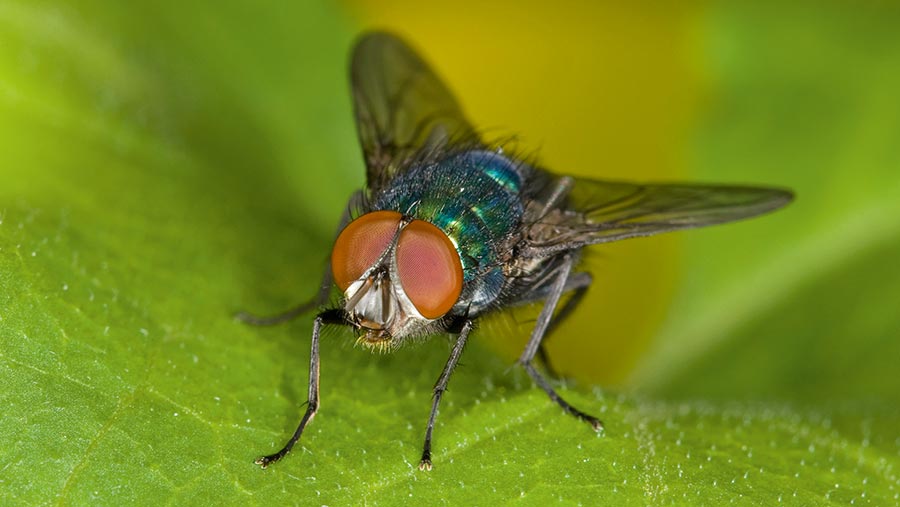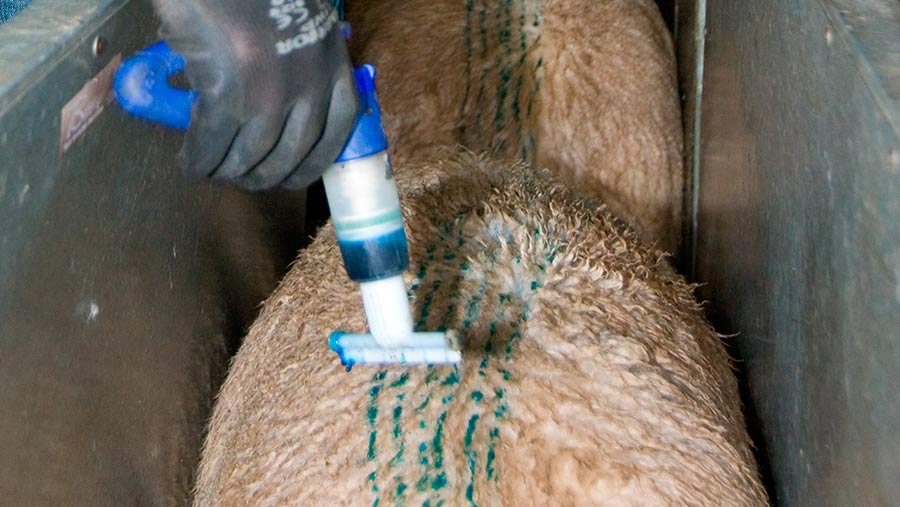Q&A: How to prevent and treat blowfly strike in sheep
 © Roger Tidman/FLPA/imageBROKER/REX/Shutterstock
© Roger Tidman/FLPA/imageBROKER/REX/Shutterstock Warmer, wetter weather seen in the UK in recent years can increase the blowfly risk to sheep as these favourable conditions result in a more abundant fly population.
Blowfly strike is a familiar annual problem, with 88% of farmers recently saying it is the most widespread ectoparasite affecting sheep in the UK, with strike occurring on more than 80% of UK farms.
See also: Q&A: How to tackle scald in sheep
It is a major welfare issue, causing lameness if the strike affects foot lesions, weight loss and possible death if untreated.
With 49% of farmers agreeing prevention is the best practice when it comes to blowfly, Elanco Animal Health is encouraging farmers to take control and strike first against the parasite using preventative products.
Elanco technical consultant Matt Colston explains what the dangers of blowfly are and how farmers can best ensure they aren’t caught out in this Q&A, with additional information from Nadis
1. What is blowfly and how is it caused?
Blowfly strike can be caused by several types of fly: the greenbottle fly; the blackbottle fly and the bluebottle fly.
The greenbottle fly is known as a “primary fly”. It initiatives a strike on a sheep with soiled fleece or wounds.
The blackbottle and bluebottle flies are “secondary flies”, meaning they attack areas that have already been struck or damaged.
Adult greenbottle females deposit their eggs on the animal which hatch into larvae. The larvae feed on the soft tissue of the skin, becoming maggots in around three days if conditions are favourable for them. These maggots cause skin and muscle damage by secreting enzymes as they eat.
The toxins released by damaged tissues and ammonia secreted by the maggots are absorbed through the lesions into the sheep’s bloodstream, and can cause illness and death.
Secondary bacterial infections are common and can cause death if left untreated.
Unlike sheep scab and lice, most of the blowfly lifecycle occurs off the sheep and adult flies can travel large distances between farms.
2. When are sheep at highest risk from blowfly?
From the end of March until we get a frost in the autumn. It’s quite variable depending on the weather each season. The most common time to see it is in mid-summer.
In addition, any sheep with an injury, or area with damaged or soiled fleece, becomes more attractive to blowfly, so this is something to watch out for.
Specific locations on the farm can also cause particular problems, such as areas where there are relatively high levels of humidity and low wind speeds – for example, sheltered, damp spots on the farm.
3. Is there anything that can be done to prevent it?
Yes. Insect growth regulators (IGRs) are preventative products. IGRs work by preventing the first-stage larvae developing into the second-stage larvae – it’s this stage of larvae that starts to damage the skin and cause problems.
Historically, people have used organophosphate (OP) dips, but these tend to have a shorter protection period and are a bit variable.
You also need to have a certificate of competence before using these products. Other preventatives include the synthetic pyrethroid (SP) pour-ons.
They are insecticidal and provide a degree of prevention to the areas they touch when applied with a fan spray.

© Tim Scrivener
Nadis recommends the following strategies to reduce the risk of blowfly strike in the flock:
- Use of the NADIS blowfly alert to identify the periods of highest risk and take preventative action
- Shearing ewes prior to the onset of the high-risk period
- Control of parasitic gastroenteritis caused by roundworms in lambs to reduce diarrhoea and therefore faecal contamination of the fleece
- Dagging or crutching of fleece around the tail area to reduce fleece soiling
- Dipping or use of pour-on chemical formulations to prevent strike or inhibit larval growth
- Correct disposal of carcases in order to minimise suitable areas for flies to lay eggs
- Ensure all wounds and footrot lesions are treated promptly
- Trapping flies to help reduce overall fly populations – this must be used in conjunction with other control methods.
4. What symptoms should farmers look out for?
Keep an eye out for staining of the fleece and sheep nibbling themselves.
However, by the time you see these symptoms the damage is already done, so it is better for a farmer to strike first and prevent the damage rather than treat it once it has already happened.
Don’t wait until it’s too late, as by that point you will probably have lost a couple of lambs.
Nadis lists additional clinical signs as:
- Isolation from the flock
- Agitation and kicking the affected area
- Disturbed grazing
- Tissue decay
- Toxaemia (blood poisoning by the toxins from bacterial infection.)
5. Is it treatable?
In the event of strike, treatment is via a SP pour-on, but because of the degree of damage and the speed at which it happens, you may need more treatment. This is because the SPs kill the maggots, but you may need to treat the wound as well.
6. What product should farmers use?
IGRs are narrow-spectrum products against blowfly, so they are ideal to use when only blowfly protection is needed.
Correct application for all medicines is important to ensure you get the most out of them. Follow packaging instructions and use the correct applicators in all cases.
See Scops for treatment options where you can download a product guide to treatment and control options for blowfly strike.
7. If left untreated, what economic and welfare implications could blowfly strike have?
It is a horrible condition and has a huge effect on animal health and welfare, as well as emotional and financial implications for the farmer. If left untreated, it will cause death.
The animals that survive take a long time to recover, which in turn has a long-term effect on growth rate and productivity.
For the farmer, the stress and worry of having potential welfare issues in the flock are extreme.
